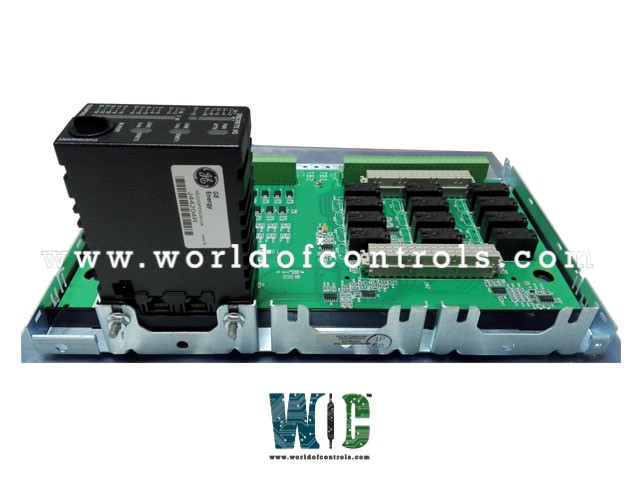
World Of Controls understands the criticality of your requirement and works towards reducing the lead time as much as possible.
IS230TDBSH6AA - Contact Input/Relay Output Terminal Board is available in stock which ships the same day.
IS230TDBSH6AA - Contact Input/Relay Output Terminal Board comes in UNUSED as well as REBUILT condition.
To avail our best deals for IS230TDBSH6AA - Contact Input/Relay Output Terminal Board, contact us and we will get back to you within 24 hours.
SPECIFICATIONS:
Part Number: IS230TDBSH6AA
Manufacturer: General Electric
Series: Mark VIe
Product Type: Contact Input/Relay Output Terminal Board
Number of input channels: 24
Number of relay channels: 12
Trip Solenoid Rating: 125 V dc
Span: -8 mV to +45 mV
Power supply voltage: 28 V dc
Voltage Range: 18 - 32 VDC
Mounting: DIN-rail mounting
Technology: Surface mount
Operating temperature: 40 to 70°C
Size: 168 x 150 x 55 mm
Repair: 3-7 Day
Availability: In Stock
Country of Origin: United States
Manual: GEH-6721D
FUNCTIONAL DESCRIPTION:
IS230TDBSH6AA is a Contact Input/Relay Output Terminal Board manufactured and designed by General Electric as part of the Mark VIe Series used in GE Distributed Control Systems. The TDBS board is a simplex contact input/output terminal board designed for DIN-rail or flat mounting. The TDBS board accepts 24 group isolated contact inputs that are supplied with a nominal 24, 48, or 125 V dc wetting voltage from an external source. The contact inputs have noise suppression to protect against surge and high-frequency noise. TDBS provides 12 form-C relay outputs and accepts different option cards to expand relay functions. In the Mark VIe systems, the PDIO I/O pack works with the TDBS. The I/O pack plugs into the D-type connector and communicates with the controller over Ethernet. A single connection point for PDIO is provided with one or two network connections possible from PDIO to the controllers.
INSTALLATION:
The TDBS plus a plastic insulator mounts on a sheet metal carrier that then mounts on a DIN rail. Optionally the TDBS plus insulator mounts on a sheet metal assembly that then bolts in a cabinet. The connections are wired directly to two sets of 48-point terminal blocks, typically using #18 AWG wires. The upper set of terminals, TB1, connects to the relay portion of the board and the lower set of terminals, TB2, connects to the contact input circuits. Screw assignments for the two sets of terminals are identical to those found on the SRLY relay board and the STCI contact input terminal board. Shields should be terminated on a separate bracket. If a relay option board is used, it plugs into TDBS connectors JW1 and JW2 and is held in place by the force of the connectors. The following table identifies the function of each relay terminal point grouped as TB1 as it relates to the presence of an option board. If external power is to be supplied it is wired to a connector provided on the option board.
OPERATION:
The contact input function and on-board signal conditioning are the same as those on STCI, they are scaled for 24, 48, and 125 V dc wetting voltage. The input wetting voltage range is 16 to 32 V dc, 32 to 64 V dc, and 100 to 145 V dc respectively. The threshold voltage is 50% of the wetting voltage. The contact sensing circuits are shown in the I/O pack description. Contact input currents are resistance limited to 2.5 mA on the first 21 circuits, and 10 mA on circuits 22 through 24. The 24 V dc supply on TDBSH2 is currently limited to 0.5 A using polymer positive temperature coefficient fuses that can be reset. Filters reduce high-frequency noise and suppress surgeon input near the point of signal entry. The discrete input voltage signals go to the I/O processor which passes them through optical isolators, converts them to digital signals, and transfers them to the controller.
WOC has the largest stock of OEM replacement parts for GE Distributed Turbine Control systems. We can also repair your faulty boards and supply unused and rebuilt boards backed up with a warranty. Our team of experts is available round the clock to support your OEM needs. Our team of experts at WOC is happy to assist you with any of your automation requirements. For pricing and availability on any parts and repairs, kindly contact our team by phone or email.
What is a Contact Input/Relay Output Terminal Board?
A Contact Input/Relay Output Terminal Board is an interface device used in control systems to connect various inputs and outputs to a central controller. It typically features terminals for connecting sensors, switches, and other input devices, as well as relays for controlling actuators, motors, lights, and other output devices.
Can the relay outputs handle both AC and DC loads?
Yes, most relay outputs are designed to handle both AC and DC loads, but it is important to check the specifications for each specific relay to ensure compatibility with your load requirements.
What kind of isolation is provided between input and output channels?
Isolation is typically provided using optical isolation (optocouplers) or magnetic isolation (transformers) to prevent electrical noise and surges from affecting the control system. This also helps in protecting sensitive components from damage.